
NPS photo There are 31 species of cacti in the monument, from the giant saguaro to the miniature pincushion, all well adapted to survive the harsh desert climate. Spines give protection and shade, thick waxy stems seal in water, and photosynthesis happens at night to keep precious water from evaporating. Keep an eye on the ground for the unique remnants of long-passed desert icons. The internal woody frames, or “skeletons, ribs, and bones” of these cacti are left behind after the plant dies. Tall column-like “columnar” cacti such as saguaro, organ pipe, and senita leave behind long and straight woody ribs. Cholla skeletons are woody tubes with holes. Small cacti like the pincushion may leave behind a nest of entwined spines that hold the cactus’s shape long after the rest of plant is gone. Below are some common cacti and succulents found in the monument. 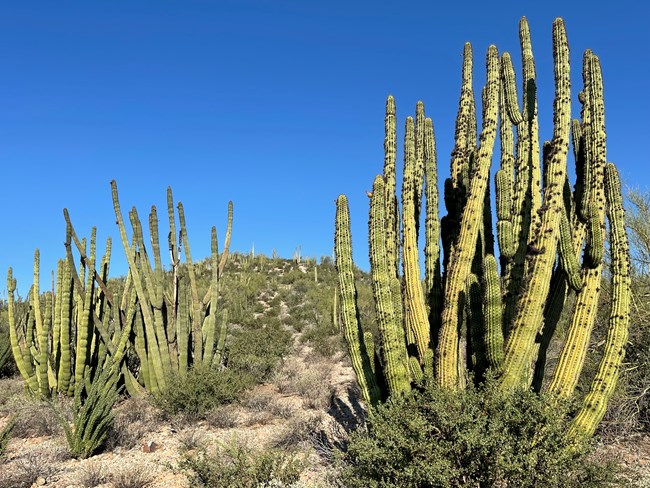
NPS photo Organ Pipe (Stenocereus thurberi)This many-limbed cactus is the monument’s namesake, and for good reason. The monument hosts the northernmost wild growing members of this species. This species relies on and provides food for some important animals here. The endangered lesser long-nosed bat (Leptonycteris curasoae) and the white-winged dove feed on the nectar through the night and following day and pollinate the plants. Fruit is consumed and seeds are dispersed by bats, birds, and bighorn sheep, as well as human inhabitants. This species can live for about 150 years. Visit the Organ Pipe Cactus page to learn more about our namesake! Identify this CactusOrgan pipe cactus sends many columnar stems out from the base, occasionally sprouting additional limbs from higher up branches. The 5-15 feet tall (1.5-4.5) limbs have 12-19 prominent ridges running its length, and groups of black spines. During the middle of summer, flower buds will appear, blossoming white to pink flowers for just one night and into the next day, before drying up. Fruits are round, thin-skinned, reddish, and covered in small spines. The monument is the northernmost extent of the organ pipe’s range, and they tend to grow on southern slopes to maximize sun exposure. 
NPS photo Saguaro (Carnegiea gigantea)This iconic cactus of the desert southwest is the tallest cactus species in North America, usually reaching heights of 45 feet (14 m), though the tallest saguaro measured was 78 feet tall (23 m). These columnar cacti take 10 years to grow one inch in height and may sprout arms after its first 90 years of life, or 10-15 feet of growth. Woodpeckers will often drill nesting cavities into saguaros that will also be used by other creatures for many seasons. The saguaro is a culturally important part of the Sonoran Desert, with the Tohono O’odham calendar being built around the harvest of the ripe fruit or “bahidaj”. This slow growing cactus may live longer than 150 years. Visit the Saguaro page to learn more about this iconic cactus! Identify this CactusSaguaros are often the tallest plant in the area. An older saguaro may tower over palo verde and ironwood trees nearby, though smaller ones may be found in the protective shade of these “nurse trees”. The girthy stems are covered in 19-25 deep, lengthwise ridges which are dotted with clusters of bristle-like spines. Funnel shaped flowers blossom at the top of the stems in bunches, blooming alternately for 24 hours. Fruit is roughly egg shaped and green, quickly turning bright pink and bursting open, exposing the deep red pulp and black seeds. 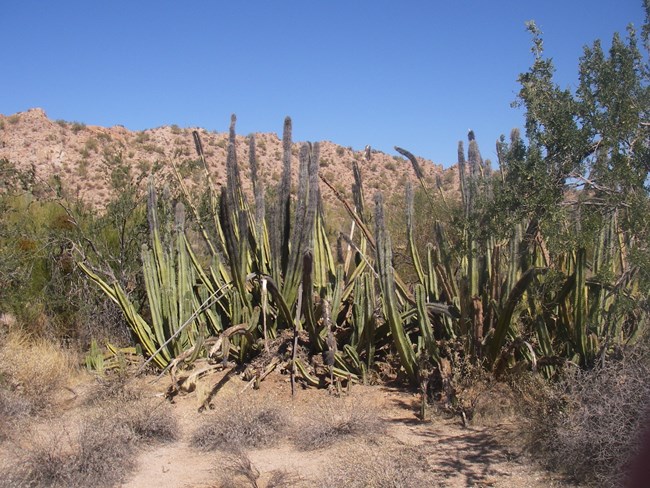
NPS photo Senita (Lophocereus schottii)The senita cactus is at the northernmost end of its range in the monument. This cactus has a unique relationship with the senita moth. The moth is the only nocturnal pollinator for this cactus, and the cactus in turn serves as a reliable food source for the moth and host plant for eggs. Traditionally the juvenile stems were cut, boiled, and the liquid consumed as a remedy to various ailments. Identify this CactusThe senita cactus grows several limbs from the ground, reaching heights of 20 feet (6 m). The stems are rarely branched, and have 5-8 ribs down the length. Spines are shorter and more orderly on the lower portions of the stems, but elongate and become shaggy at the top, lending this cactus the nickname of “old man’s beard”. Flowers white to pink in color, opening at night and closing by morning. Fruits are oval or rounded and filled with nutritious pulp that is quickly eaten by birds and ants, that is, if the larva of the senita moth haven’t already consumed it. This cactus prefers even ground and the most impressive stand in the United States can be found at Senita Basin. 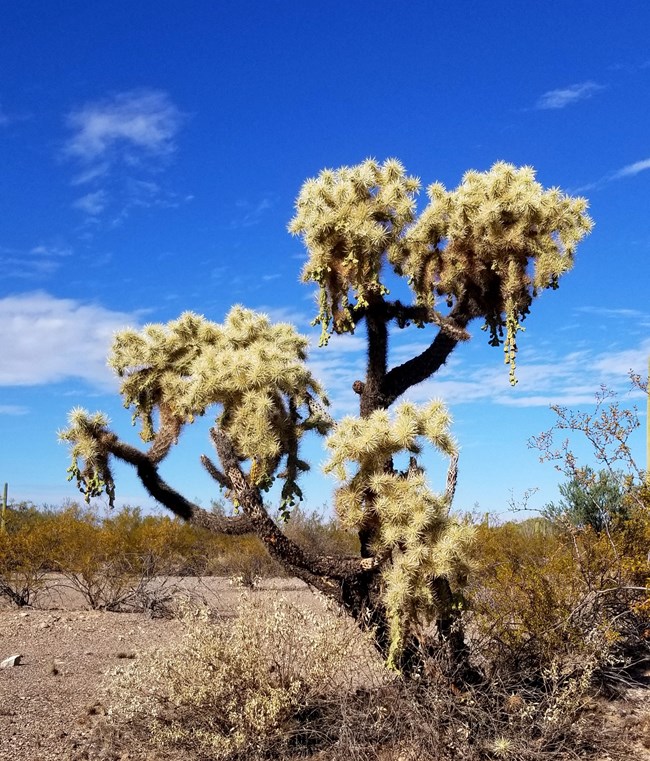
NPS photo Chain fruit cholla (Cylindropuntia fulgida)Chain fruit or jumping cholla is a common shrubby cactus found in the monument. The nickname “jumping” cholla comes from its easily detached joints that seem to jump and stick to skin or clothing that brushes it. Fruit is usually sterile, so this cactus reproduces by dropping pieces of itself, or “joints”, and sprouting a new plant through cloning. The fruit, although dry and generally not favored are very high in calcium and are regularly consumed by deer and cattle. The O’odham would eat this fruit to bolster meals during a time of scarcity, and before the tastier, more nutritious saguaro fruit ripened. Identify this CactusYou may find chain fruit chollas growing 3-5 feet tall (0.9-1.5 m) around the monument, though some may grow over 10 feet tall. This cactus is spiny all over, with 1.5 inch long (3cm) straw-colored spines covering younger, higher up stems, and breaking off of the lower portion to reveal the old, dark stem. Flowers are about the size of a quarter coin and are pink with purple or white accents. Inch-long (2.5 cm), spineless fruit is linked end-to-end and hangs in drooping “chains”. 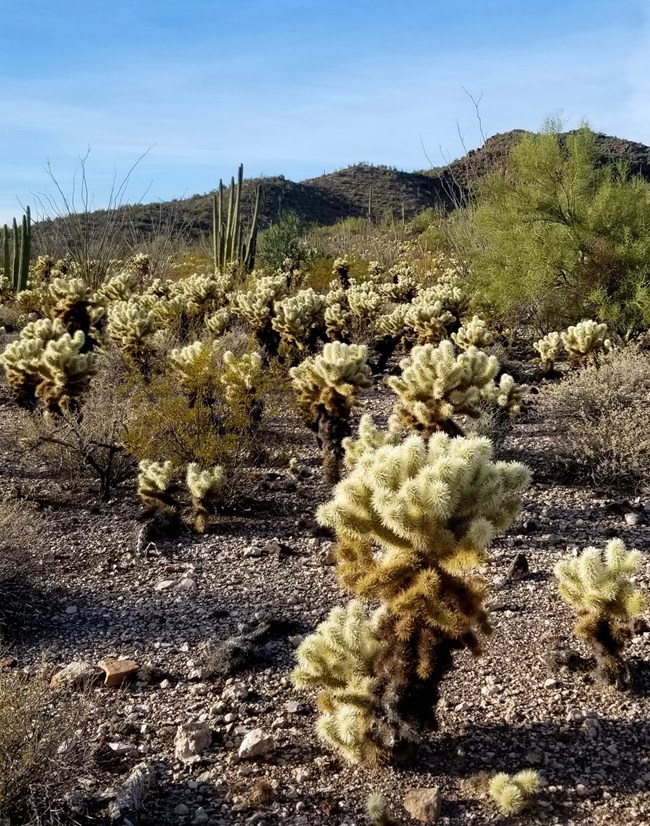
NPS photo Teddy-bear cholla (Cylindropuntia bigelovii)Teddy-bear cholla, like chain fruit cholla, has joints that easily break away to clone elsewhere. Sometimes, these joints begin to grow right next to the adult plant, or only a short distance away, creating a group of cholla known as a cholla garden. Packrats will collect cholla joints and place them around the entrances to their burrows or “middens” as protection against coyotes and kit foxes looking for a meal. Cactus wren and other small birds will similarly nest in the spiny branches of cholla for protection from predators. Identify this CactusTeddy-bear cholla is named or its all-around fuzzy appearance. Teddy-bear cholla is a stout cactus, typically standing 1-5 feet tall (0.3-1.5 m), with a crown of branches that doesn’t droop, and a dark lower trunk. Flowers are green, with red on the outside. The spines on teddy-bear cholla are fairly short and densely packed, and the whole plant is stout, whereas chain fruit cholla have more loosely arranged spines, and are taller with drooping arms. 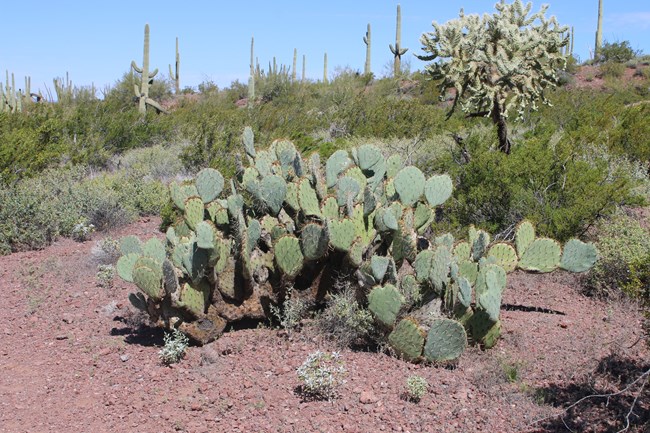
NPS photo Engelmann’s prickly pear (Opuntia engelmannii)There are several species of prickly pear cacti in the monument, but Engelmann’s prickly pear, also called the desert prickly pear, or “nopal” is the most common. Most prickly pears are famously edible cacti of the desert southwest. This the stems or pads can be harvested, and their spines removed, then sliced to size to be eaten raw or cooked in a dish. Fruits are commonly known as “tuna” in Spanish, and are popular in jams and jellies, candy, and drinks as flavoring. Identify this CactusEngelmann’s prickly pear grows in segments, usually waist high or shorter, but may grow 6 feet (2 m) or taller. Stems are flattened pads of different lengths, about the width of a pencil, and balloon shaped. Small spines radiate from points on the pads and fruits called “areoles”. These spines include tiny, barbed hairs called “glochids” that can irritate the skin. Flowers are yellow to orange and showy, with large, stacked petals. Fruit is green while young and turns magenta as it ripens. 
NPS photo Hedgehog cactus (Echinocereus sp.)Hedgehog cacti are small, attractive cacti with large blooms and edible fruit. These hardy cacti are often used as an ornamental in gardens. There are many different varieties of these cacti, growing in different deserts and terrains, though the most common in rocky areas with full sun. Flowers open for a few days, closing each night, offering those who are looking for them a window of opportunity to see the bright blooms. Identify this CactusThese cacti grow low to the ground, 3-12 inches (8-30 cm), though some species may grow slender and twice as high. Some species are solitary, while some grow in small clusters. Hedgehogs are typically barrel or cylinder shaped, with prominent ridges running from the ground to the top of the stem. Spines are variable, and may be long and many, obscuring the stem underneath, or may be few and arranged in little starbursts along the ridge. Flowers are relatively large, growing palm-sized over their stumpy stems, and showing colors ranging from bright yellow to deep red, and occasionally white. Fruits are typically red to purple in color. 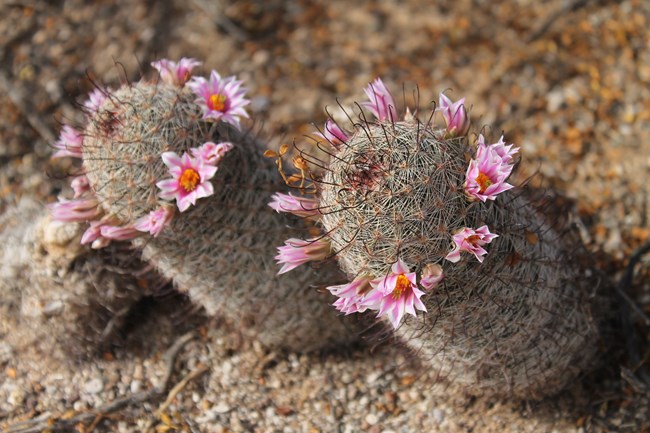
NPS photo Pincushion (Mammillaria sp.)Pincushions are named such because of their small, round bodies, with spines sticking straight out like a pincushion. Mammillaria is a large and diverse group of cacti with many different looks and functions, depending on where they grow. These cacti are more common in central and south America, but Organ Pipe hosts a few of these unique little plants. Identify this CactusPincushion cacti are typically low growing, many the size of a golf ball, but may grow to 8 inches tall (3-20 cm). These cacti are stout to slender in stature, and usually covered in delicate, fuzzy hairs and that weave into each other, creating a fuzzy white or silver look. Some species have straight spines while others have small hooks at the end. Flowers are typically pink and form a wreath around the top of the cactus. Look out for pincushions growing in the shade of a larger shrub. 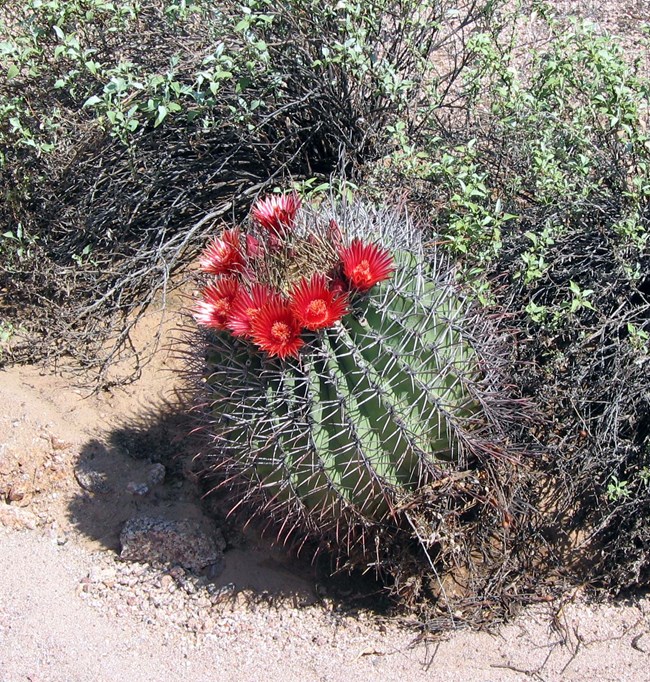
NPS photo Arizona barrel cactus (Ferocactus wislizennii)The Arizona barrel cactus is a large desert plant with durable, hooked spines which can be used as fishhooks. This cactus tends to lean towards the south to maximize sun exposure, sometimes leaning so far that it will uproot itself. Flowers appear in late summer and early fall, later than other cacti in the monument, providing early season visitors a taste of the colorful Sonoran blooms. Identify this CactusThis cactus may grow upwards of 6 feet, but are typically found growing 3-5 feet tall (1-1.5 m). A mature cactus is barrel shaped, while immature ones may be club shaped. They grow in full sun, often next to saguaros, where older barrels and younger saguaros may be confused. The Arizona barrel cactus has long, heavy, purple, hooked spines while the saguaro has more delicate straight spines. Flowers will form a tight crown of orange and red on the top of the cactus. Fruits are yellow and sought out by animals and humans alike. More About Sonoran Desert Plants |
Last updated: October 5, 2023
